Road signs in Norway

Signs follow the general European conventions concerning the use of shape and colour to indicate function. Any text included on supplementary signs will normally be in
No more than three signs (road number indications excepted) may be mounted on any one pole, with the most important sign appearing at the top. As is customary in
The current set of designs were introduced through a reform that went into effect 1 June 2006, replacing the old sets from 1967 and 1980. As the law outlining this reform was published 7 October 2005, some signs were already replaced before the law went into effect. The most notable change was the removal of hats and hair on the stickmen making them gender-neutral, but many signs were redesigned or introduced for the first time, as noted below.[1][2][3]
Norway signed the Vienna Convention on Road Signs and Signals on December 23, 1969 and ratified it on April 1, 1985.[4]
Warning signs
Warning signs are mostly triangular, with black symbols on a white background with a red border. Warning signs that are used only temporarily have a yellow background. On Svalbard, a unique warning sign with a black background and white symbol is used for polar bears.
-
Curve
Right. -
Curve
Left. -
Double curve
First to the right. -
Double curve
First to the left. -
Steep hill
Upwards. -
Steep hill
Downwards. -
Road narrows
On both sides. -
Road narrows
On right side. -
Road narrows
On left side. -
Falling rocks
Warns that rocks, soil or snow may slide onto the road, but also that chunks may be present from previous landslides. -
Falling rocks
-
Slippery road
Road is known to be especially slippery under special conditions, like rainfall. -
Crossroads
Warns about dangerous crossroads which have normal rules for traffic priority. -
Roundabout ahead
-
Traffic signals
-
Level crossing with a barrier or gate
-
Level crossing without a barrier or gate[N 2]
-
Distance to level crossing
These signs may be used to represent the distance to a level crossing in three equal parts. Closest to the crossing. -
Distance to level crossing
Between other countdown markers. -
Distance to level crossing
Furthest from the crossing. -
Children[N 2]
Warns that children often traverse or walk on the roads due to a nearby school, child-care center, playground or similar. -
Animals (moose)
Warns that moose often traverse or travel on the roads. -
Animals (reindeer)
Warns that reindeer often traverse or travel on the roads. -
Animals (deer)
Warns that deer often traverse or travel on the roads. -
Animals (cattle)
Warns that cattle often traverse or travel on the roads. -
Animals (sheep)
Warns that sheep often traverse or travel on the roads. -
Animals (polar bear)
Warns that polar bear traverse or travel on the ice. -
Two-way traffic
Warning of two-way traffic on the road ahead. -
Military activity
-
Traffic accident[N 4]
-
Other danger
Details are written on a supplementary sign. -
(1)Snowmobiles
(1) Warns that polar bears may be present.
(2) Warns that people on snowmobiles may traverse the roads.
Priority signs
-
Stop
It is mandatory to stop completely at the stop line, or if not available, as close to the crossing road or railway track as possible, before continuing. Vehicles must also give way to other traffic, or trains. -
Priority road
Priority at all following crossroads up to an end of priority road, give way or stop sign. -
End of priority road
-
Priority crossroads
Warns about dangerous crossroads where the road this sign is placed on has priority. Crossing roads have give way or stop signs. -
Give way for oncoming traffic
-
Priority over oncoming traffic
Prohibitory signs
Restrictive signs are mostly circular, with black symbols on a white background with a red border. The exceptions are zone signs which are rectangular, and no parking signs which use a red symbol on a blue background. These signs are valid from where they stand and for the entirety of the road until it is ended by another sign, or until the next crossroads depending on the specific sign.
-
No entry
-
Road closed to all traffic
-
No tractors, or motor vehicles slower than 40 km/h[N 2]
-
No motorcycles or mopeds[N 2]
-
No lorries and tractor units
-
No pedestrians[N 2]
-
No riders[N 2]
-
No transport of dangerous goods[N 1]
-
Total weight limit[N 1]
Restriction is for motor vehicles with more than two wheels and an allowed total weight limit above the given weight limit. -
Width limit
Restriction is for a vehicle including all of its goods. -
Height limit
Restriction is for a vehicle including all of its goods. -
Length limit
Restriction is for a vehicle including all of its goods. -
Weight limit for vehicles
Restriction is for each vehicle in the case of a lorry. -
Weight limit for lorries
Restriction is for the combined weight in the case of a lorry, though no single vehicle is permitted above the limit either. -
Bogie weight limit
-
Stop for control
Vehicle is not permitted to continue until the action described is done. -
Stop for tax
Vehicle is not permitted to continue until the action described is done. -
Stop for customs
Vehicle is not permitted to continue until the action described is done. -
No right turn
For the next intersection unless otherwise stated with a supplementary sign. -
No left turn
For the next intersection unless otherwise stated with a supplementary sign. -
No U-turn
Until and including the next crossroads. -
No overtaking
Restriction is for overtaking motor vehicles with more than two wheels. Overtaking on the right side is permitted by normal traffic rules. -
No overtaking for lorries[N 1]
Restriction is for lorries with a total weight above 3.500 kg overtaking motor vehicles with more than two wheels. Overtaking on the right side is permitted by normal traffic rules. -
End of no overtaking
-
End of no overtaking for lorries[N 1]
-
Speed limit
Speed limit of given km/h until new speed limit, end of special speed limit, speed limit zone or any pedestrian precinct sign. -
End of special speed limit
This means a general speed limit of 50 km/h in populated areas and 80 km/h in rural areas by law. -
Speed limit zone
Speed limit of given km/h until end of speed limit, end of speed limit zone or any pedestrian precinct sign. -
Speed limit zone for small electric vehicles
Speed limit of 6 km/h (3.7 mph) for small electric vehicles until of end of speed limit zone. -
End of speed limit zone
-
End of speed limit zone for small electric vehicles
-
No stopping
No stops until the next crossing road or until another sign ends it. -
No parking
No parking on the side of the road where the sign is until the next crossing road or until another sign ends it. -
Parking zone
Parking permitted until end of parking zone sign. Often with supplementary text about when the sign is valid. -
No parking zone
No parking permitted until end of parking zone sign. Often with supplementary text about when the sign is valid. -
No parking zone for small electric vehicles
No parking permitted for small electric vehicles on public areas until end of parking zone sign. -
End of parking zone
-
End of no parking zone
-
End of no parking zone for small electric vehicles
-
No small electric vehicle zone
Small electric vehicles must not be operated until end of no small electric vehicle zone. Riders must push or carry their vehicle within the zone. -
End of no small electric vehicle zone
Mandatory signs
Mandatory signs are all circular like the restrictive signs, but feature white symbols on a blue background.
-
Proceed right
-
Proceed left
-
Proceed straight
-
Turn right
-
Turn left
-
Drive straight or turn right
-
Drive straight or turn left
-
Turn right or left
-
Pass on right
-
Pass on left
-
Roundabout[N 2]
-
Mandatory direction in roundabout
Informative signs
Some of the informative signs are restrictive (for example, one-way street, and bus lane).
-
Motorway
Speed limit is 80 km/h unless another limit is set, which it normally is. 110 km/h is the highest limit found, and is set on the highest standard motorways. Lower limits may be set on lower standard or busier roads. -
Motor traffic road
Speed limit is 80 km/h unless another limit is specifically set. Some are signposted to 90 km/h. -
End of motorway
-
End of motor traffic road
-
Heavy traffic lane
Only vehicles with allowed total weight higher than indicated can use this lane. -
End of heavy traffic lane
-
Bus lane[a]
-
Bus and taxi lane[a]
-
Car-pool lane[N 1]
Only vehicles with more than indicated occupants including driver can use this lane. Buses and taxis, regardless of how many occupants, can also use this lane.[b] -
End of bus lane
-
End of bus and taxi lane
-
End of car-pool lane[N 1]
-
Bus stop
-
Tram stop[N 1]
-
Taxi stop
-
Pedestrian crossing[N 2]
-
Pedestrian crossing[N 2]
-
Cycle track[N 6]
-
Cycle lane (edge)[N 1]
-
Cycle lane (centered)[N 4]
-
Shared-use footway[N 6]
-
Passing place
("Møteplass" in Norwegian.) Used frequently on long stretches of single-track roads. Parking forbidden. -
One-way
-
One-way
-
Dead end
Road physically closed. -
Dead end
Side-road physically closed. -
Dead end[N 1]
Road closed for motor vehicles. -
Dead end[N 1]
Side-road closed for motor vehicles. -
Free choice of lane
-
Merging lanes
Merging by the“zipper method”. -
Merging roads with speed regulation lane
Oncoming lane has to adapt. Merging by the “zipper method”. -
Merging roads with speed regulation lane
This lane has to adapt. Merging by the “zipper method”. -
End of lane
The ending lane has to give way. -
New lane starts
-
Added lane with oncoming traffic
-
Lane division
Denotes the number of lanes and what direction they go. -
Changed driving pattern[N 1]
May be used in conjunction with roadworks. -
End of living street[N 6]
-
Pedestrian zone[N 1]
Motor vehicles are normally prohibited in pedestrian zone, except small electric vehicles. If exemption is granted by a supplementary sign, the speed limit is "walking speed." -
End of pedestrian zone[N 1]
-
Parking
-
Emergency layby
To be used only in case of vehicle breakdown or other emergency. -
Speed limit enforced by automatic camera[N 1]
-
Speed limit enforced by automatic camera - average speed measurement
A flashing yellow indicator is also placed at the end of speed measurement zone. This will flash if the vehicle's measured average speed exceeded the speed limit. -
Video surveillance[N 1]
-
Information board
Alternative: 1
Sign 560 may provide information about miscellaneous traffic conditions. May have a brown background if the information is specifically aimed at tourists. Must have a yellow background if it's a temporary sign, or an orange background if it provides information about detours. -
General speed limits
Information board posted on border crossings on Norwegian national roads, Norwegian county roads and ferry terminals. -
Pedestrians and cyclist prohibited
On motorways and motor traffic roads -
Speed measuring
-
Wrong way[N 4]
-
Emergency exit
For tunnels. -
Direction and distance to emergency exit
For tunnels.
Service signs
-
Radio channel
DAB digital radio relays special traffic announcement messages. -
First aid
-
Emergency phone[N 2]
-
Fire extinguisher[N 2]
-
Automobile repair shop
-
Electric vehicle fast charging station
-
Petrol station[N 2]
-
Fuel
Text vary. LPG is replaced by fuel type e.g. CNG. -
Toilet emptying facility[N 1]
For caravans, buses, etc. -
Toilet
-
Rest stop[N 2]
-
Rest stop with toilet[N 1]
-
Simple dining[N 2]
-
Dining
-
Camp site[N 2]
-
Caravan park[N 1]
-
Camping park[N 2]
-
Hostel[N 2]
-
Bed & breakfast[N 4]
-
Hotel[N 2]
-
Information[N 2]
-
Tourist information office[N 1]
-
Attraction[N 3]
Symbol may be replaced by a representation of the attraction. -
Museum or art gallery[N 1]
-
Viewpoint[N 1]
-
Protected natural area
-
National fortifications
-
Fishing area[N 1]
-
Hiking trail[N 1]
-
Ski trail[N 1]
-
Bicycle trail
-
Traditional food and rural tourism[N 1]
-
Olavsrosa
Seal of Quality
Direction signs
Direction signs inform about places, businesses, routes, choice of lanes, choice of roads and distance to destinations. Direction signs with a yellow background (blue on motorways) show geographical destinations. Direction signs with a white background (or white fields on yellow and blue signs) show local destinations. Direction signs with a brown background show destinations of special interest to tourism. Orange backgrounds denote temporary detours.
-
Orientation board[N 6]
-
Diagram orientation board[N 6]
-
Exit board[N 6]
-
Lane orientation board[N 6]
Shows number of lanes towards an intersection, and which directions or destinations each of them are intended for. -
Portal orientation board[N 6]
Used on portals. Shows which directions or destinations a lane is intended for. -
Board guide[N 6]
-
Regular destination guide[N 6]
-
Lane guide[N 1]
Shows which destination a lane is intended for. -
Portal guide[N 6]
Used on portals. Shows which destination a lane is intended for. -
European route
-
European route
Signifies a route that leads to the given route. -
Trunk road[N 1]
Signifies a route that leads to the given route. -
Numbered province road
-
Numbered province road
Signifies a route that leads to the given route. -
Ring road[N 1]
-
Ring road[N 1]
Signifies a route that leads to the given ring road. -
National tourist road[N 1]
Symbol may be used on service signs. -
Detour for large vehicles
-
Route for vehicles with dangerous goods[N 1]
-
Miscellaneous detour[N 1]
Signifies a detour where use of road names is not viable. One symbol is used for the entire route, so that different symbols may be used in the event of multiple routes. The line is generally used. -
Miscellaneous detour[N 1]
-
Miscellaneous detour[N 1]
-
Miscellaneous detour[N 1]
-
Miscellaneous detour[N 1]
Generally only used under special circumstances, as some countries use this symbol on detours for vehicles with dangerous goods. -
Miscellaneous detour[N 1]
Different arrows may be used to show the right direction. -
Intersection number[N 1]
Blue for motorways with multiple lanes. Intended solely for orientation. -
Intersection number[N 1]
Yellow for general roads with multiple lanes. -
Intersection number[N 1]
Yellow for general roads with a single lane. -
Region name sign[N 6]
City/urban area. -
Region name sign[N 6]
Administrative border. -
Region name sign[N 6]
Place name of significance to orientation. -
Tunnel name sign[N 6]
Placed at the entrance to the tunnel. The length is also written on the sign. -
Street sign
-
Collective guide sign[N 1]
Shows destinations that may be reached through the same road at the next crossroads or exit. -
Detour for certain vehicles[N 1]
-
Temporary detour[N 6]
-
Temporary detour
-
End of temporary detour[N 1]
-
Guide for pedestrians[N 6]
-
Guide for bicycle route
-
Board guide for bicycle route
-
Bicycle route
-
Distance sign for bicycle route
-
Motorway[N 6]
-
Motor traffic road [N 6]
-
Toll road[N 7]
-
Parking[N 6]
-
Multistory car park[N 7]
-
Airport[N 6]
-
Helipad[N 7]
-
Bus station/terminal[N 7]
-
Train station/terminal[N 7]
-
Ferry[N 6]
-
Cargo port
-
Suitable layby for equipping tire chains[N 4]
Steep hill ahead. Tire chains are required for trucks over 3,5 tonnes during severe winter conditions. -
Church[N 6]
-
Industrial area[N 6]
-
Shopping center
-
Swimming hall[N 7]
-
Alpine facility[N 7]
-
Ski jump slope[N 7]
-
Ski arena[N 7]
-
Golf course[N 7]
-
Payment with electronic chip[N 7]
-
Payment to attendant[N 7]
-
Payment with coins to machine[N 7]
-
Payment with card to machine[N 7]
-
Payment with banknotes to machine[N 7]
-
Remove ticket from closed payment system[N 7]
-
Use ticket in closed payment system[N 7]
-
Automatic toll road[N 7]
No stopping required.
Supplementary signs
-
Distance
Advance warning about where the main sign goes into effect, or where a corresponding sign is set up. -
Stretch
Main sign is in effect for the given distance. -
Time
Main sign is only in effect between given times. Black numbers in parentheses apply on Saturdays, and red numbers apply on Sundays and official holidays. -
Car
Main sign applies to this type of vehicle. -
Light commercial vehicle, lorry and tractor unit
-
Bus
-
Vehicle with trailer
-
Trailer furnished for camping (caravan)
-
Motorcycle and moped[N 2]
-
Handicapped driver
Requires a visible parking permit for handicapped drivers. -
Vehicle furnished for camping (motorhome)[N 1]
-
Small electric vehicle
-
Text
Used when there are no symbols that represent the regulation or information. Depicted sign is common and says: “Does not apply to buses and taxis”. -
Turn arrow
Arrows vary. Main sign applies after the turn. -
Recommended speed
-
Uphill inclination[N 1]
-
Inclination
-
Actual available width
-
Crossing lumber transport[N 2]
-
Particular danger of accident[N 1]
Symbol varies. -
Course of priority road
Symbol varies. Priority road is represented by the thick line. Roads represented by thin lines have give way or stop signs for the priority road. -
Advance warning for stop sign
-
Bicycle traffic in both directions[N 2]
-
Direction for a stop or parking regulation sign
-
Direction for a stop or parking regulation sign
-
Direction for a stop or parking regulation sign
-
Arrangement for parked vehicles[N 1]
-
Parking board[N 1]
Indicates that parking is only allowed by given regulations when a valid parking ticket or disc is placed highly visible inside the windshield. -
Combined regulation
In this example, the times written only applies for cars.
Marker signs
Marker signs inform drivers of a road's onward course, or warn of obstacles near or on the road. Temporary marker signs, e.g. during roadworks, use a red background colour.
-
Directional marker
-
Directional marker
-
Directional marker
Used on long or dangerous bends. -
Directional marker
Used on long or dangerous bends. -
Obstacle marker
Keep left of the sign. -
Obstacle marker
Keep right of the sign. -
Obstacle marker
Pass on either side. -
Obstacle marker
-
Lanes diverge either side of the marker
Used mainly on high-speed roads. -
Tunnel marker
-
Tunnel marker
-
Distance marker for tunnels[N 1]
Indicates the distance to each exit. -
Reflexion post
-
Reflexion post
-
Reflexion post
-
Traffic cone
-
Traffic cylinder
Notes
- ^ a b Electric and hydrogen vehicles, motorcycles, mopeds, bicycles, small electric vehicles, and marked emergency vehicles can also use this lane, unless otherwise stated by a supplementary sign.
- ^ Electric and hydrogen vehicles, motorcycles, mopeds, bicycles, small electric vehicles, and marked emergency vehicles, regardless of how many occupants, can also use this lane, unless otherwise stated by a supplementary sign.
- ^ a b c d e f g h i j k l m n o p q r s t u v w x y z aa ab ac ad ae af ag ah ai aj ak al am an ao ap aq ar as at au av aw ax ay az ba bb New sign per 1 June 2006.[5]
- ^ a b c d e f g h i j k l m n o p q r s t u v w x y z aa ab ac ad ae af ag ah Changed symbol per 2006 reform.[5]
- ^ a b c Changed colour per 2006 reform.[5]
- ^ a b c d e New sign per 1 January 2012.[6]
- ^ a b c d Updated definition since 15 June 2022.[7]
- ^ a b c d e f g h i j k l m n o p q r s t u v w x y z aa ab New shape per 2006 reform.[5]
- ^ a b c d e f g h i j k l m n o p q r New symbol per 2006 reform.[5]
References
- ^ "Lovdata" (in Norwegian).
- ^ "Statens Vegvesen" (in Norwegian).
- ^ "Bogart og selbyggen skal vekk". Adressa (in Norwegian). 3 February 2006. Retrieved 5 June 2011.
- ^ "United Nations Treaty Collection". treaties.un.org. Retrieved 2023-12-09.
- ^ a b c d e "Hast AS" (in Norwegian). Retrieved 6 June 2011.
- ^ "Norwegian Public Roads Administration" (in Norwegian). Archived from the original on 16 April 2014. Retrieved 10 August 2012.
- ^ "Forskrift om endring i forskrift om offentlige trafikkskilt, vegoppmerking, trafikklyssignaler og anvisninger (skiltforskriften) - Lovdata". lovdata.no (in Norwegian Bokmål). Retrieved 18 June 2022.
- ^ "Archived copy" (PDF). Archived from the original (PDF) on 2019-12-27. Retrieved 2022-02-16.
{{cite web}}: CS1 maint: archived copy as title (link)





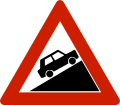



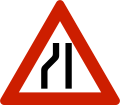

![Speed bump[N 1]](http://upload.wikimedia.org/wikipedia/commons/thumb/6/65/NO_road_sign_109.svg/120px-NO_road_sign_109.svg.png)
![Roadworks[N 2][N 3]](http://upload.wikimedia.org/wikipedia/commons/thumb/9/90/NO_road_sign_110.svg/120px-NO_road_sign_110.svg.png)




![Dangerous verges[N 1]](http://upload.wikimedia.org/wikipedia/commons/thumb/4/48/NO_road_sign_117.svg/120px-NO_road_sign_117.svg.png)


![Tunnel ahead[N 2]](http://upload.wikimedia.org/wikipedia/commons/thumb/a/a5/NO_road_sign_122.svg/120px-NO_road_sign_122.svg.png)




![Level crossing without a barrier or gate[N 2]](http://upload.wikimedia.org/wikipedia/commons/thumb/b/b6/NO_road_sign_135.svg/120px-NO_road_sign_135.svg.png)

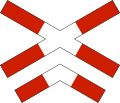
![Tramway[N 1]](http://upload.wikimedia.org/wikipedia/commons/thumb/a/a4/NO_road_sign_139.svg/120px-NO_road_sign_139.svg.png)
![Pedestrian crossing ahead[N 2] Distance represented with supplementary sign](http://upload.wikimedia.org/wikipedia/commons/thumb/5/5d/NO_road_sign_140.svg/120px-NO_road_sign_140.svg.png)
![Children[N 2] Warns that children often traverse or walk on the roads due to a nearby school, child-care center, playground or similar.](http://upload.wikimedia.org/wikipedia/commons/thumb/0/0a/NO_road_sign_142.svg/120px-NO_road_sign_142.svg.png)
![Cyclists[N 2] Warns that cyclists often traverse or travel on the roads.](http://upload.wikimedia.org/wikipedia/commons/thumb/a/a3/NO_road_sign_144.svg/120px-NO_road_sign_144.svg.png)







![Traffic queues[N 1]](http://upload.wikimedia.org/wikipedia/commons/thumb/2/28/NO_road_sign_149.svg/120px-NO_road_sign_149.svg.png)
![Low-flying aircraft[N 2]](http://upload.wikimedia.org/wikipedia/commons/thumb/f/f2/NO_road_sign_150.svg/120px-NO_road_sign_150.svg.png)

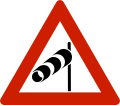
![Traffic accident[N 4]](http://upload.wikimedia.org/wikipedia/commons/thumb/e/ef/NO_road_sign_153.svg/120px-NO_road_sign_153.svg.png)
![Riders[N 2] Warns that riders often traverse or travel on the roads.](http://upload.wikimedia.org/wikipedia/commons/thumb/a/a7/NO_road_sign_155.svg/120px-NO_road_sign_155.svg.png)



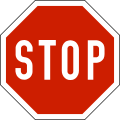






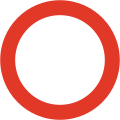
![No motor vehicles except small electric vehicles[N 5][N 2]](http://upload.wikimedia.org/wikipedia/commons/thumb/3/32/NO_road_sign_306.1.svg/120px-NO_road_sign_306.1.svg.png)
![No tractors, or motor vehicles slower than 40 km/h[N 2]](http://upload.wikimedia.org/wikipedia/commons/thumb/3/32/NO_road_sign_306.3.svg/120px-NO_road_sign_306.3.svg.png)
![No motorcycles or mopeds[N 2]](http://upload.wikimedia.org/wikipedia/commons/thumb/f/f0/NO_road_sign_306.4.svg/120px-NO_road_sign_306.4.svg.png)

![No cyclists and riders of small electric vehicle[N 5][N 2]](http://upload.wikimedia.org/wikipedia/commons/thumb/b/ba/NO_road_sign_306.6.svg/120px-NO_road_sign_306.6.svg.png)
![No pedestrians[N 2]](http://upload.wikimedia.org/wikipedia/commons/thumb/c/cb/NO_road_sign_306.7.svg/120px-NO_road_sign_306.7.svg.png)
![No pedestrians, cyclists, and riders of small electric vehicle[N 5][N 2]](http://upload.wikimedia.org/wikipedia/commons/thumb/9/97/NO_road_sign_306.8.svg/120px-NO_road_sign_306.8.svg.png)
![No riders[N 2]](http://upload.wikimedia.org/wikipedia/commons/thumb/b/bd/NO_road_sign_306.9.svg/120px-NO_road_sign_306.9.svg.png)

![No transport of dangerous goods[N 1]](http://upload.wikimedia.org/wikipedia/commons/thumb/2/24/NO_road_sign_308.svg/120px-NO_road_sign_308.svg.png)
![Total weight limit[N 1] Restriction is for motor vehicles with more than two wheels and an allowed total weight limit above the given weight limit.](http://upload.wikimedia.org/wikipedia/commons/thumb/d/d4/NO_road_sign_310.svg/120px-NO_road_sign_310.svg.png)
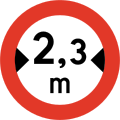




![Axle weight limit[N 2] No vehicle with weight above the given limit for each axle, and maximum 150% of the limit for each bogie.](http://upload.wikimedia.org/wikipedia/commons/thumb/f/fa/NO_road_sign_320.svg/120px-NO_road_sign_320.svg.png)








![No overtaking for lorries[N 1] Restriction is for lorries with a total weight above 3.500 kg overtaking motor vehicles with more than two wheels. Overtaking on the right side is permitted by normal traffic rules.](http://upload.wikimedia.org/wikipedia/commons/thumb/3/3f/NO_road_sign_335.svg/120px-NO_road_sign_335.svg.png)

![End of no overtaking for lorries[N 1]](http://upload.wikimedia.org/wikipedia/commons/thumb/1/15/NO_road_sign_337.svg/120px-NO_road_sign_337.svg.png)

















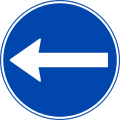




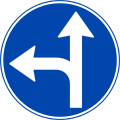
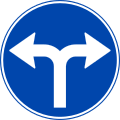


![Roundabout[N 2]](http://upload.wikimedia.org/wikipedia/commons/thumb/8/88/NO_road_sign_406.svg/120px-NO_road_sign_406.svg.png)




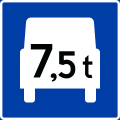

![Bus lane[a]](http://upload.wikimedia.org/wikipedia/commons/thumb/c/c3/NO_road_sign_508.1.svg/120px-NO_road_sign_508.1.svg.png)
![Bus and taxi lane[a]](http://upload.wikimedia.org/wikipedia/commons/thumb/6/64/NO_road_sign_508.2.svg/120px-NO_road_sign_508.2.svg.png)
![Car-pool lane[N 1] Only vehicles with more than indicated occupants including driver can use this lane. Buses and taxis, regardless of how many occupants, can also use this lane.[b]](http://upload.wikimedia.org/wikipedia/commons/thumb/4/44/NO_road_sign_509.svg/120px-NO_road_sign_509.svg.png)


![End of car-pool lane[N 1]](http://upload.wikimedia.org/wikipedia/commons/thumb/1/18/NO_road_sign_511.svg/120px-NO_road_sign_511.svg.png)

![Tram stop[N 1]](http://upload.wikimedia.org/wikipedia/commons/thumb/8/80/NO_road_sign_513.svg/120px-NO_road_sign_513.svg.png)

![Pedestrian crossing[N 2]](http://upload.wikimedia.org/wikipedia/commons/thumb/6/66/NO_road_sign_516.H.svg/120px-NO_road_sign_516.H.svg.png)
![Pedestrian crossing[N 2]](http://upload.wikimedia.org/wikipedia/commons/thumb/c/c3/NO_road_sign_516.V.svg/120px-NO_road_sign_516.V.svg.png)
![Pedestrian way[N 6]](http://upload.wikimedia.org/wikipedia/commons/thumb/5/51/NO_road_sign_518.svg/120px-NO_road_sign_518.svg.png)
![Cycle track[N 6]](http://upload.wikimedia.org/wikipedia/commons/thumb/7/7f/NO_road_sign_520.svg/120px-NO_road_sign_520.svg.png)
![Cycle lane (edge)[N 1]](http://upload.wikimedia.org/wikipedia/commons/thumb/1/15/NO_road_sign_521.1.svg/120px-NO_road_sign_521.1.svg.png)
![Cycle lane (centered)[N 4]](http://upload.wikimedia.org/wikipedia/commons/thumb/8/8d/Norwegian-road-sign-521.1.png/120px-Norwegian-road-sign-521.1.png)
![Shared-use footway[N 6]](http://upload.wikimedia.org/wikipedia/commons/thumb/f/ff/NO_road_sign_522.svg/120px-NO_road_sign_522.svg.png)





![Dead end[N 1] Road closed for motor vehicles.](http://upload.wikimedia.org/wikipedia/commons/thumb/6/60/NO_road_sign_527.3.svg/100px-NO_road_sign_527.3.svg.png)
![Dead end[N 1] Side-road closed for motor vehicles.](http://upload.wikimedia.org/wikipedia/commons/thumb/9/9d/NO_road_sign_527.4V.svg/100px-NO_road_sign_527.4V.svg.png)








![Changed driving pattern[N 1] May be used in conjunction with roadworks.](http://upload.wikimedia.org/wikipedia/commons/thumb/5/57/Norwegian-road-sign-539.svg/115px-Norwegian-road-sign-539.svg.png)
![Living street[N 6] The speed limit is "walking speed."](http://upload.wikimedia.org/wikipedia/commons/thumb/b/ba/NO_road_sign_540.svg/90px-NO_road_sign_540.svg.png)
![End of living street[N 6]](http://upload.wikimedia.org/wikipedia/commons/thumb/6/6b/NO_road_sign_542.svg/90px-NO_road_sign_542.svg.png)
![Pedestrian zone[N 1] Motor vehicles are normally prohibited in pedestrian zone, except small electric vehicles. If exemption is granted by a supplementary sign, the speed limit is "walking speed."](http://upload.wikimedia.org/wikipedia/commons/thumb/a/a1/NO_road_sign_548.svg/90px-NO_road_sign_548.svg.png)
![End of pedestrian zone[N 1]](http://upload.wikimedia.org/wikipedia/commons/thumb/e/ef/NO_road_sign_550.svg/90px-NO_road_sign_550.svg.png)


![Speed limit enforced by automatic camera[N 1]](http://upload.wikimedia.org/wikipedia/commons/thumb/1/12/NO_road_sign_556.1.svg/120px-NO_road_sign_556.1.svg.png)

![Video surveillance[N 1]](http://upload.wikimedia.org/wikipedia/commons/thumb/7/76/NO_road_sign_558.svg/120px-NO_road_sign_558.svg.png)
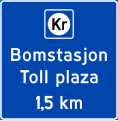



![Wrong way[N 4]](http://upload.wikimedia.org/wikipedia/commons/thumb/e/e3/Norwegian-road-sign-565.png/79px-Norwegian-road-sign-565.png)
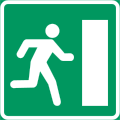


![Emergency phone[N 2]](http://upload.wikimedia.org/wikipedia/commons/thumb/4/46/NO_road_sign_605.svg/120px-NO_road_sign_605.svg.png)
![Fire extinguisher[N 2]](http://upload.wikimedia.org/wikipedia/commons/thumb/d/d5/NO_road_sign_606.svg/120px-NO_road_sign_606.svg.png)


![Petrol station[N 2]](http://upload.wikimedia.org/wikipedia/commons/thumb/4/41/NO_road_sign_610.1.svg/120px-NO_road_sign_610.1.svg.png)

![Toilet emptying facility[N 1] For caravans, buses, etc.](http://upload.wikimedia.org/wikipedia/commons/thumb/9/9e/NO_road_sign_611.svg/120px-NO_road_sign_611.svg.png)

![Rest stop[N 2]](http://upload.wikimedia.org/wikipedia/commons/thumb/6/64/NO_road_sign_613.1.svg/120px-NO_road_sign_613.1.svg.png)
![Rest stop with toilet[N 1]](http://upload.wikimedia.org/wikipedia/commons/thumb/2/2d/NO_road_sign_613.2.svg/120px-NO_road_sign_613.2.svg.png)
![Simple dining[N 2]](http://upload.wikimedia.org/wikipedia/commons/thumb/1/18/NO_road_sign_614.svg/120px-NO_road_sign_614.svg.png)

![Camp site[N 2]](http://upload.wikimedia.org/wikipedia/commons/thumb/c/cf/NO_road_sign_618.svg/120px-NO_road_sign_618.svg.png)
![Caravan park[N 1]](http://upload.wikimedia.org/wikipedia/commons/thumb/d/d4/NO_road_sign_621.svg/120px-NO_road_sign_621.svg.png)
![Camping park[N 2]](http://upload.wikimedia.org/wikipedia/commons/thumb/8/84/NO_road_sign_622.svg/120px-NO_road_sign_622.svg.png)
![Hostel[N 2]](http://upload.wikimedia.org/wikipedia/commons/thumb/1/16/NO_road_sign_624.svg/120px-NO_road_sign_624.svg.png)
![Bed & breakfast[N 4]](http://upload.wikimedia.org/wikipedia/commons/thumb/d/d7/Norwegian-road-sign-625.png/120px-Norwegian-road-sign-625.png)
![Hotel[N 2]](http://upload.wikimedia.org/wikipedia/commons/thumb/e/e8/NO_road_sign_626.svg/120px-NO_road_sign_626.svg.png)
![Information[N 2]](http://upload.wikimedia.org/wikipedia/commons/thumb/4/4d/NO_road_sign_635.svg/120px-NO_road_sign_635.svg.png)
![Tourist information office[N 1]](http://upload.wikimedia.org/wikipedia/commons/thumb/d/d7/NO_road_sign_637.svg/120px-NO_road_sign_637.svg.png)
![Attraction[N 3] Symbol may be replaced by a representation of the attraction.](http://upload.wikimedia.org/wikipedia/commons/thumb/2/29/NO_road_sign_640.10.svg/120px-NO_road_sign_640.10.svg.png)
![Museum or art gallery[N 1]](http://upload.wikimedia.org/wikipedia/commons/thumb/0/0b/NO_road_sign_640.12.svg/120px-NO_road_sign_640.12.svg.png)
![Viewpoint[N 1]](http://upload.wikimedia.org/wikipedia/commons/thumb/f/f2/NO_road_sign_640.20.svg/120px-NO_road_sign_640.20.svg.png)
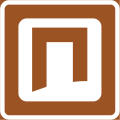
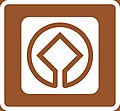

![Activities, outdoor recreation, etc.[N 2][N 3]](http://upload.wikimedia.org/wikipedia/commons/thumb/6/60/NO_road_sign_650.10.svg/120px-NO_road_sign_650.10.svg.png)
![Fishing area[N 1]](http://upload.wikimedia.org/wikipedia/commons/thumb/d/d7/NO_road_sign_650.11.svg/120px-NO_road_sign_650.11.svg.png)
![Hiking trail[N 1]](http://upload.wikimedia.org/wikipedia/commons/thumb/3/37/NO_road_sign_650.20.svg/120px-NO_road_sign_650.20.svg.png)
![Ski trail[N 1]](http://upload.wikimedia.org/wikipedia/commons/thumb/9/99/NO_road_sign_650.21.svg/120px-NO_road_sign_650.21.svg.png)

![Traditional food and rural tourism[N 1]](http://upload.wikimedia.org/wikipedia/commons/thumb/6/64/NO_road_sign_650.40.svg/120px-NO_road_sign_650.40.svg.png)

![Orientation board[N 6]](http://upload.wikimedia.org/wikipedia/commons/thumb/a/a7/Norwegian-road-sign-701.svg/120px-Norwegian-road-sign-701.svg.png)
![Diagram orientation board[N 6]](http://upload.wikimedia.org/wikipedia/commons/thumb/4/4a/Norwegian-road-sign-703.svg/120px-Norwegian-road-sign-703.svg.png)
![Exit board[N 6]](http://upload.wikimedia.org/wikipedia/commons/thumb/2/25/Norwegian-road-sign-705.svg/120px-Norwegian-road-sign-705.svg.png)
![Lane orientation board[N 6] Shows number of lanes towards an intersection, and which directions or destinations each of them are intended for.](http://upload.wikimedia.org/wikipedia/commons/thumb/f/f9/Norwegian-road-sign-707.svg/120px-Norwegian-road-sign-707.svg.png)
![Board guide[N 6]](http://upload.wikimedia.org/wikipedia/commons/thumb/7/74/Norwegian-road-sign-711.svg/103px-Norwegian-road-sign-711.svg.png)
![Exit guide[N 6] Alternative: 1](http://upload.wikimedia.org/wikipedia/commons/b/b8/Norwegian-road-sign-715a.png)
![Lane guide[N 1] Shows which destination a lane is intended for.](http://upload.wikimedia.org/wikipedia/commons/thumb/c/ce/Norwegian-road-sign-717.svg/120px-Norwegian-road-sign-717.svg.png)


![Trunk road[N 1]](http://upload.wikimedia.org/wikipedia/commons/thumb/c/c4/Norwegian-road-sign-723.13.svg/120px-Norwegian-road-sign-723.13.svg.png)
![Trunk road[N 1] Signifies a route that leads to the given route.](http://upload.wikimedia.org/wikipedia/commons/thumb/3/3d/Norwegian-road-sign-723.14.svg/120px-Norwegian-road-sign-723.14.svg.png)


![Ring road[N 1]](http://upload.wikimedia.org/wikipedia/commons/thumb/e/e8/Norwegian-road-sign-723.21.svg/120px-Norwegian-road-sign-723.21.svg.png)
![Ring road[N 1] Signifies a route that leads to the given ring road.](http://upload.wikimedia.org/wikipedia/commons/thumb/4/40/Norwegian-road-sign-723.22.svg/120px-Norwegian-road-sign-723.22.svg.png)
![National tourist road[N 1] Symbol may be used on service signs.](http://upload.wikimedia.org/wikipedia/commons/thumb/4/4d/NO_road_sign_723.31.svg/120px-NO_road_sign_723.31.svg.png)

![Route for vehicles with dangerous goods[N 1]](http://upload.wikimedia.org/wikipedia/commons/thumb/2/2f/NO_road_sign_723.51.svg/120px-NO_road_sign_723.51.svg.png)
![Miscellaneous detour[N 1] Signifies a detour where use of road names is not viable. One symbol is used for the entire route, so that different symbols may be used in the event of multiple routes. The line is generally used.](http://upload.wikimedia.org/wikipedia/commons/thumb/b/b7/NO_road_sign_723.61.svg/120px-NO_road_sign_723.61.svg.png)
![Miscellaneous detour[N 1]](http://upload.wikimedia.org/wikipedia/commons/thumb/6/6c/NO_road_sign_723.62.svg/120px-NO_road_sign_723.62.svg.png)
![Miscellaneous detour[N 1]](http://upload.wikimedia.org/wikipedia/commons/thumb/c/cf/NO_road_sign_723.63.svg/120px-NO_road_sign_723.63.svg.png)
![Miscellaneous detour[N 1]](http://upload.wikimedia.org/wikipedia/commons/thumb/a/af/NO_road_sign_723.64.svg/120px-NO_road_sign_723.64.svg.png)
![Miscellaneous detour[N 1] Generally only used under special circumstances, as some countries use this symbol on detours for vehicles with dangerous goods.](http://upload.wikimedia.org/wikipedia/commons/thumb/d/d9/NO_road_sign_723.65.svg/120px-NO_road_sign_723.65.svg.png)
![Miscellaneous detour[N 1] Different arrows may be used to show the right direction.](http://upload.wikimedia.org/wikipedia/commons/thumb/6/62/Norwegian-road-sign-723.66.svg/120px-Norwegian-road-sign-723.66.svg.png)
![Intersection number[N 1] Yellow for general roads with a single lane.](http://upload.wikimedia.org/wikipedia/commons/thumb/a/a7/Norwegian-road-sign-723.73.svg/120px-Norwegian-road-sign-723.73.svg.png)
![Region name sign[N 6] Country border. Bilingual Bokmål and Sami in Troms and Finnmark, bilingual Bokmål and Nynorsk in other counties.[8]](http://upload.wikimedia.org/wikipedia/commons/thumb/c/c8/NO_road_sign_727.3RBN.svg/77px-NO_road_sign_727.3RBN.svg.png)
![Tunnel name sign[N 6] Placed at the entrance to the tunnel. The length is also written on the sign.](http://upload.wikimedia.org/wikipedia/commons/thumb/e/ec/Norwegian-road-sign-727.4.png/120px-Norwegian-road-sign-727.4.png)
![Collective guide sign[N 1] Shows destinations that may be reached through the same road at the next crossroads or exit.](http://upload.wikimedia.org/wikipedia/commons/thumb/b/ba/Norwegian-road-sign-731.svg/88px-Norwegian-road-sign-731.svg.png)
![Detour for certain vehicles[N 1]](http://upload.wikimedia.org/wikipedia/commons/thumb/b/bf/Norwegian-road-sign-741.svg/79px-Norwegian-road-sign-741.svg.png)


![End of temporary detour[N 1]](http://upload.wikimedia.org/wikipedia/commons/thumb/7/7f/NO_road_sign_745.svg/90px-NO_road_sign_745.svg.png)



![Motorway[N 6]](http://upload.wikimedia.org/wikipedia/commons/thumb/7/7c/NO_road_sign_761.svg/120px-NO_road_sign_761.svg.png)
![Motor traffic road [N 6]](http://upload.wikimedia.org/wikipedia/commons/thumb/8/84/NO_road_sign_763.svg/120px-NO_road_sign_763.svg.png)

![Parking[N 6]](http://upload.wikimedia.org/wikipedia/commons/thumb/a/ac/NO_road_sign_767.svg/120px-NO_road_sign_767.svg.png)
![Multistory car park[N 7]](http://upload.wikimedia.org/wikipedia/commons/thumb/1/11/NO_road_sign_769.svg/120px-NO_road_sign_769.svg.png)
![Airport[N 6]](http://upload.wikimedia.org/wikipedia/commons/thumb/a/a8/NO_road_sign_771.svg/120px-NO_road_sign_771.svg.png)
![Helipad[N 7]](http://upload.wikimedia.org/wikipedia/commons/thumb/1/1a/NO_road_sign_772.svg/120px-NO_road_sign_772.svg.png)
![Bus station/terminal[N 7]](http://upload.wikimedia.org/wikipedia/commons/thumb/1/14/NO_road_sign_773.svg/120px-NO_road_sign_773.svg.png)
![Train station/terminal[N 7]](http://upload.wikimedia.org/wikipedia/commons/thumb/5/5a/NO_road_sign_774.svg/120px-NO_road_sign_774.svg.png)
![Ferry[N 6]](http://upload.wikimedia.org/wikipedia/commons/thumb/5/5a/NO_road_sign_775.svg/120px-NO_road_sign_775.svg.png)

![Suitable layby for equipping tire chains[N 4] Steep hill ahead. Tire chains are required for trucks over 3,5 tonnes during severe winter conditions.](http://upload.wikimedia.org/wikipedia/commons/thumb/0/04/Norwegian-road-sign-780.png/120px-Norwegian-road-sign-780.png)
![Church[N 6]](http://upload.wikimedia.org/wikipedia/commons/thumb/a/a2/NO_road_sign_790.10.svg/120px-NO_road_sign_790.10.svg.png)
![Industrial area[N 6]](http://upload.wikimedia.org/wikipedia/commons/thumb/2/25/NO_road_sign_790.15.svg/120px-NO_road_sign_790.15.svg.png)

![Swimming hall[N 7]](http://upload.wikimedia.org/wikipedia/commons/thumb/7/79/NO_road_sign_790.20.svg/120px-NO_road_sign_790.20.svg.png)
![Alpine facility[N 7]](http://upload.wikimedia.org/wikipedia/commons/thumb/c/c7/NO_road_sign_790.30.svg/120px-NO_road_sign_790.30.svg.png)
![Ski jump slope[N 7]](http://upload.wikimedia.org/wikipedia/commons/thumb/2/28/NO_road_sign_790.31.svg/120px-NO_road_sign_790.31.svg.png)
![Ski arena[N 7]](http://upload.wikimedia.org/wikipedia/commons/thumb/b/bd/NO_road_sign_790.32.svg/120px-NO_road_sign_790.32.svg.png)
![Golf course[N 7]](http://upload.wikimedia.org/wikipedia/commons/thumb/0/04/NO_road_sign_790.40.svg/120px-NO_road_sign_790.40.svg.png)
![Payment with electronic chip[N 7]](http://upload.wikimedia.org/wikipedia/commons/thumb/b/b6/NO_road_sign_792.11.svg/120px-NO_road_sign_792.11.svg.png)
![Payment to attendant[N 7]](http://upload.wikimedia.org/wikipedia/commons/thumb/f/f7/NO_road_sign_792.12.svg/120px-NO_road_sign_792.12.svg.png)
![Payment with coins to machine[N 7]](http://upload.wikimedia.org/wikipedia/commons/thumb/8/89/NO_road_sign_792.13.svg/120px-NO_road_sign_792.13.svg.png)
![Payment with card to machine[N 7]](http://upload.wikimedia.org/wikipedia/commons/thumb/e/e4/NO_road_sign_792.14.svg/120px-NO_road_sign_792.14.svg.png)
![Payment with banknotes to machine[N 7]](http://upload.wikimedia.org/wikipedia/commons/thumb/8/8a/NO_road_sign_792.15.svg/120px-NO_road_sign_792.15.svg.png)
![Remove ticket from closed payment system[N 7]](http://upload.wikimedia.org/wikipedia/commons/thumb/b/b3/NO_road_sign_792.16.svg/120px-NO_road_sign_792.16.svg.png)
![Use ticket in closed payment system[N 7]](http://upload.wikimedia.org/wikipedia/commons/thumb/8/8b/NO_road_sign_792.17.svg/120px-NO_road_sign_792.17.svg.png)
![Automatic toll road[N 7] No stopping required.](http://upload.wikimedia.org/wikipedia/commons/thumb/0/05/NO_road_sign_792.30.svg/120px-NO_road_sign_792.30.svg.png)






![Bicycle and small electric vehicle[N 5][N 2]](http://upload.wikimedia.org/wikipedia/commons/thumb/2/2b/NO_road_sign_807.6.svg/120px-NO_road_sign_807.6.svg.png)
![Motorcycle and moped[N 2]](http://upload.wikimedia.org/wikipedia/commons/thumb/b/b9/NO_road_sign_807.7.svg/120px-NO_road_sign_807.7.svg.png)

![Vehicle furnished for camping (motorhome)[N 1]](http://upload.wikimedia.org/wikipedia/commons/thumb/7/7f/NO_road_sign_807.9.svg/120px-NO_road_sign_807.9.svg.png)


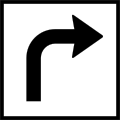

![Uphill inclination[N 1]](http://upload.wikimedia.org/wikipedia/commons/thumb/c/c7/NO_road_sign_813.1.svg/120px-NO_road_sign_813.1.svg.png)

![Particular danger of accident[N 1] Symbol varies.](http://upload.wikimedia.org/wikipedia/commons/thumb/5/5a/Norwegian-road-sign-817.1.svg/120px-Norwegian-road-sign-817.1.svg.png)
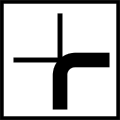

![Bicycle traffic in both directions[N 2]](http://upload.wikimedia.org/wikipedia/commons/thumb/d/d4/NO_road_sign_826.svg/120px-NO_road_sign_826.svg.png)
![Arrangement for parked vehicles[N 1]](http://upload.wikimedia.org/wikipedia/commons/thumb/a/a8/Norwegian-road-sign-829.0.svg/120px-Norwegian-road-sign-829.0.svg.png)
![Parking board[N 1] Indicates that parking is only allowed by given regulations when a valid parking ticket or disc is placed highly visible inside the windshield.](http://upload.wikimedia.org/wikipedia/commons/thumb/a/a0/Norwegian-road-sign-831.0.svg/120px-Norwegian-road-sign-831.0.svg.png)




![Distance marker for tunnels[N 1] Indicates the distance to each exit.](http://upload.wikimedia.org/wikipedia/commons/thumb/5/59/Norwegian-road-sign-916.0.svg/92px-Norwegian-road-sign-916.0.svg.png)

